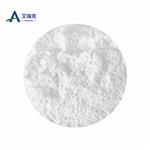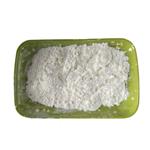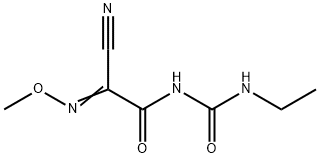Cymoxanil
- CAS No.
- 57966-95-7
- Chemical Name:
- Cymoxanil
- Synonyms
- Cymoxani;1-Cyano-N-[(ethylamino)carbonyl]-2-(methoxyimino)acetamide;PULSAN;CURZATE;DPX 3217;dpx3217m;RIFLE XG;CYMOXANIL;CIMOXPRON;MANEX C-8
- CBNumber:
- CB6676584
- Molecular Formula:
- C7H10N4O3
- Molecular Weight:
- 198.18
- MDL Number:
- MFCD00137381
- MOL File:
- 57966-95-7.mol
- MSDS File:
- SDS
| Melting point | 160-161° |
|---|---|
| Boiling point | 335.48°C (rough estimate) |
| Density | 1.3841 (rough estimate) |
| vapor pressure | 1.5 x 10-4 Pa (20 °C) |
| refractive index | 1.6700 (estimate) |
| Flash point | 100 °C |
| storage temp. | 0-6°C |
| solubility | DMSO: 100 mg/mL (504.59 mM) |
| pka | 9.7 |
| Water Solubility | 890 mg l-1 (pH 5), 780 mg l-1 (pH 7), unstable at pH 9 at 20 °C |
| color | White to Light yellow to Light orange |
| Merck | 14,2765 |
| BRN | 2214018 |
| LogP | 0.590 |
| CAS DataBase Reference | 57966-95-7(CAS DataBase Reference) |
| EWG's Food Scores | 1-2 |
| FDA UNII | QJO7SS7R8U |
| NIST Chemistry Reference | Acetamide, 2-cyano-n-[(ethylamino)carbonyl]-2-(methoxyimino)-(57966-95-7) |
| EPA Substance Registry System | Cymoxanil (57966-95-7) |
SAFETY
Risk and Safety Statements
| Symbol(GHS) |    GHS07,GHS08,GHS09 |
|||||||||
|---|---|---|---|---|---|---|---|---|---|---|
| Signal word | Warning | |||||||||
| Hazard statements | H302-H317-H361fd-H373-H410 | |||||||||
| Precautionary statements | P201-P273-P280-P301+P312+P330-P302+P352-P308+P313 | |||||||||
| Hazard Codes | Xn;N,N,Xn | |||||||||
| Risk Statements | 22-43-50/53 | |||||||||
| Safety Statements | 36/37-60-61 | |||||||||
| RIDADR | UN 3077 | |||||||||
| WGK Germany | 3 | |||||||||
| RTECS | AB5957000 | |||||||||
| HazardClass | 9 | |||||||||
| PackingGroup | III | |||||||||
| HS Code | 29269090 | |||||||||
| Toxicity | For 80% formulations, LD50 orally in male rats: 1425 mg/kg; dermally in male rabbits: >3000 mg/kg. LC50 orally in bobwhite quails, mallard ducks: 2847, >10000 ppm. LC50 (96 hr) in bluegill sunfish, rainbow trout (ppm): 13.5, 18.7 (Klopping, Delp). | |||||||||
| NFPA 704 |
|
Cymoxanil price More Price(25)
| Manufacturer | Product number | Product description | CAS number | Packaging | Price | Updated | Buy |
|---|---|---|---|---|---|---|---|
| Sigma-Aldrich | 34326 | Cymoxanil PESTANAL | 57966-95-7 | 100mg | $122 | 2024-03-01 | Buy |
| TCI Chemical | C2657 | Cymoxanil | 57966-95-7 | 5G | $16 | 2024-03-01 | Buy |
| TCI Chemical | C2657 | Cymoxanil | 57966-95-7 | 25G | $42 | 2024-03-01 | Buy |
| Cayman Chemical | 24232 | Cymoxanil ≥98% | 57966-95-7 | 5mg | $32 | 2024-03-01 | Buy |
| Cayman Chemical | 24232 | Cymoxanil ≥98% | 57966-95-7 | 10mg | $57 | 2024-03-01 | Buy |
Cymoxanil Chemical Properties,Uses,Production
Description
Cymoxanil was first introduced in 1977. It is an acetimide compound used as both a curative and preventative foliar fungicide. In Europe it is being sold for use on grapes, potatoes, tomatoes, hops, sugarbeets and other vegetable crops. Cymoxanil is currently not registered in the U.S. Cymoxanil is a fungicide used on crops including potatoes, tomatoes, and grapes. Cymoxanil is not registered for non-crop use in any country. Cymoxanil's mode of action is as a local systemic. It penetrates rapidly and when inside the plant, it cannot
be washed off by rain. It controls diseases during the incubation period and prevents the appearance of damage on the crop. The fungicide is primarily active on fungi belonging to the Peronosporales order: Phytophthora, Plasmopara, and Peronospora.
Physical Properties
Technical cymoxanil is a peach colored crystalline, odorless solid.
Toxicity
Technical cymoxanil has low acute toxicity. The acute oral LD50 is 960 mg/kg in rats. The acute dermal LD50 is >2,000 mg/kg in rabbits. The 4-hour rat inhalation LC50 is >5.06 mg/L. Minimal transient irritation of the skin and eyes was observed in rabbits. Cymoxanil did not cause skin sensitization in guinea pigs. Cymoxanil should be classified as Toxicity Category III for oral and dermal toxicity and Toxicity Category IV for inhalation toxicity and skin and eye irritation potential.
Absorption, Distribution and Excretion
Cymoxanil is rapidly absorbed and maximum concentrations in the blood and plasma is reached within 4 hours after dosing. Rapid and almost complete elimination of the administered radioactive dose was observed in urine and feces within 48 hours. Excretion is primarily by urine (64-75%), fecal (16-24%) and expired air (< 5%) of the administered dose. There is no significant difference in residue profiles or elimination rates between sexes, dose levels, or single or multiple dosing. No evidence of bioaccumulation was detected. DPX-T3217 is metabolized extensively and only trace level of the administered (14)C-cymoxanil was detected in the urine and feces.
Absorption, Distribution and Excretion
Cymoxanil is rapidly absorbed and maximum concentrations in the blood and plasma is reached within 4 hours after dosing. Rapid and almost complete elimination of the administered radioactive dose was observed in urine and feces within 48 hours. Excretion is primarily by urine (64-75%), fecal (16-24%) and expired air (< 5%) of the administered dose. There is no significant difference in residue profiles or elimination rates between sexes, dose levels, or single or multiple dosing. No evidence of bioaccumulation was detected. DPX-T3217 is metabolized extensively and only trace level of the administered (14)C-cymoxanil was detected in the urine and feces.
Uses
Efficient fungicide
References
1. http://pmep.cce.cornell.edu/profiles/extoxnet/carbaryl-dicrotophos/cymoxanil-ext.html
2. https://toxnet.nlm.nih.gov/cgi-bin/sis/search2/r?dbs+hsdb:@term+@rn+@rel+112-31-2
3. http://www.agchemaccess.com/Cymoxanil
Description
Cymoxanil is a cyanoacetamide fungicide. It inhibits the mycelial growth of 12 isolates of P. infestans with EC50 values of 0.27-0.57 μg/ml. Cymoxanil (5-100 mg/l) inhibits the growth of several strains of S. cerevisiae (IC50s = 8-25 mg/l) but not S. pombe, K. marxianus, P. anomala, or C. utilis. A spray application of cymoxanil (1 mg/mL) one day after inoculation of potato leaves with P. infestans and cucumber leaves with P. cubensis reduces blighted leaves by 79 and 60%, respectively. It is toxic to rats with an acute LD50 value of 3.8 mmol/kg. Formulations containing cymoxanil have been used to prevent fungal growth on crops and treat late potato blight in agriculture.
Chemical Properties
A white to peach (pale pink) crystalline solid.
Uses
Agricultural fungicide.
Uses
Cymoxanil is a fungicide applied as a seed treatment or as a foliar application to the plants to control late blight.
Uses
Cymoxanil is a foliar applied fungicide which provides preventive and curative control of pathogen species of the order Peronosporales (eg. Phytophthora, Plasmopara and Peronospora) in grapes, potatoes, tomatoes, hops, tobacco and cucurbits.
Definition
ChEBI: A member of the class of ureas that is urea in which the two nitrogen atoms are substituted by an ethyl group and a 2-cyano-2-(methoxyimino)acetyl group respectively. A fungicide used to control Peronosporales on a range of crops including vin s, hops and potatoes.
Agricultural Uses
Fungicide: Cymoxanil is applied as a seed treatment to cut potato seed pieces or as a foliar to control late blight.
Trade name
CURZATE®; DPX 3217®; DPX 3217 M®; DPX-T3217®; EVOLVE®; MZ-CURZATE®; TANOS® Cymoxanil
Contact allergens
Cymoxanil, an urea derivative, is included (10%) with dithianone (25%) in Aktuan?. It is a fungicide agent, possibly sensitizing agricultural workers
Potential Exposure
Cymoxanil is a cyanoacetamide oxime fungicide applied as a seed treatment to cut potato seed pieces or as a foliar to control late blight.
Metabolic pathway
Cymoxanil is rapidly degraded in neutral to alkaline aqueous solutions and is metabolised extensively in soil, plants and animals. Cymoxanil degradation follows a series of cyclisation and /or hydrolysis reactions to form 5- and 6-membered ring compounds and shorter chain keto acids and amides. In plants and animals, cymoxanil is metabolised to form natural products, especially glycine.
Metabolism
Animals
Radiolabeled cymoxanil is metabolized in the goat to
natural products, including fatty acids, glycerol, glycerin,
and other amino acids, lactose, and acid-hydrolysable
formyl and acetyl groups.
Plants
Rapid degradation to naturally occurring amino acids,
particularly to glycine, with subsequent incorporation into
constituent sugars, starch, fatty acids, and lignin (6).
Soil
In laboratory soils, DT50 0.75–1.5 d (5 soils, pH range
5.7–7.8, o.m. 0.8–3.5%). In the field, DT50 (bare soil)
0.9–9 d.
Shipping
UN3077 Environmentally hazardous substances, solid, n.o.s., Hazard class: 9; Labels: 9-Miscellaneous haz- ardous material, Technical Name Required.
Degradation
The hydrolysis of cymoxanil is pH dependent. It degraded rapidly in
alkaline solution at 25 °C with calculated DT50 values at pH 5,7 and 9, of
148 days, 34 hours and 31 minutes, respectively (PM). The principal
hydrolysis products at pH 9 were 1-ethyldihydro-dimino-2,4,5(3H)-
pyrimidinetrione 5-(O-methyloxime) (2), cyano(methoxyimino)acetic acid
(3) and [[(ethylamino)carbonyl]amino]oxoacetic acid (4). Oxalic(5) and
aminooxoacetic acid (6) were recovered as minor products. The principal
degradation products at pH 7 were compounds 2 and 4. No hydrolytic
products at pH 5 exceeded 10% of the applied radioactivity throughout
the 30-day incubation (Lawler, 1996).
Photolysis of cymoxanil occurred rapidly at pH 5 when irradiated
under a xenon arc light source. The DT50 values of cymoxanil at 25 °C were 1.8 and 148 days, light exposed vs. dark control, respectively. 3-Ethyl-4-
(methoxyamino)-2,5-dioxo-4-imidazolidinecarbonitrile(7) and 1-ethyl-imidazolidinetrione
5-(O-methyloxime) (8) were the major degradation
products. Compounds 2, 4, 6 and ethylimidazolidinetrione (9) were
also present as minor products (Anderson et al., 1993). The hydrolytic
degradation and photolytic degradation pathways of cymoxanil are presented
in Scheme 1.
Environmental considerations
Oral LD50 for bobwhite quail and mallard ducks >2,250 mg/kg. Eight-day dietary LC50 for bobwhite quail and mallard ducks >5,620 mg/kg diet. Fish LC50 (in mg/L at 96 h): rainbow trout 61, bluegill sunfish 29, common carp 91, Zebra fish >47.5 mg/L. Earthworm LC50 (14 d) >2,208 mg/kg soil. Daphnia magna LC50 (48 h) 27 mg/L. Algal growth inhibition LC50 (72 h) 5.2 mg/L. Honeybee contact LD50 >25 μg/bee.
Toxicity evaluation
Rat oral LD50: 960 mg/kg, mouse oral LD50: 860 mg/kg. Rabbit dermal LD50: >2,000 mg/kg. Mild eye irritant to rabbit (clears at 48 h). Mild, transient dermal irritation to rabbit (clears at 48 h). Inhalation LC50 (4 h) for male and female rats >5.06 mg/L. Nononcogenic and nonteratogenic.
Incompatibilities
Slowly hydrolyzes in water, releasing ammonia and forming acetate salts. Light sensitive.
Waste Disposal
Do not discharge into drains or sewers. Burn in incinerator specifically designed for pes- ticide disposal or dispose as a Hazardous waste in a landfill approved and licensed for the disposal of pesticides. Consult with environmental regulatory agencies for guid- ance on acceptable disposal practices. Ultimate disposal of the chemical must consider: the material’s impact on air quality; potential migration in soil or water; effects on ani- mal, aquatic, and plant life; and conformance with environ- mental and public health regulations.
Cymoxanil Preparation Products And Raw materials
| Supplier | Tel | Country | ProdList | Advantage | |
|---|---|---|---|---|---|
| Hebei Mojin Biotechnology Co., Ltd | +8613288715578 | sales@hbmojin.com | China | 12456 | 58 |
| airuikechemical co., ltd. | +undefined86-15315557071 | sales02@airuikechemical.com | China | 994 | 58 |
| Capot Chemical Co.,Ltd. | 571-85586718 +8613336195806 | sales@capotchem.com | China | 29797 | 60 |
| Henan Tianfu Chemical Co.,Ltd. | +86-0371-55170693 +86-19937530512 | info@tianfuchem.com | China | 21691 | 55 |
| Shenzhen Nexconn Pharmatechs Ltd | +86-755-89396905 +86-15013857715 | admin@nexconn.com | China | 10248 | 58 |
| Hubei Jusheng Technology Co.,Ltd. | 18871490254 | linda@hubeijusheng.com | CHINA | 28180 | 58 |
| Hebei Guanlang Biotechnology Co., Ltd. | +86-19930503282 | alice@crovellbio.com | China | 8823 | 58 |
| Hubei xin bonus chemical co. LTD | 86-13657291602 | linda@hubeijusheng.com | CHINA | 22968 | 58 |
| Chongqing Chemdad Co., Ltd | +86-023-61398051 +8613650506873 | sales@chemdad.com | China | 39916 | 58 |
| CONIER CHEM AND PHARMA LIMITED | +8618523575427 | sales@conier.com | China | 47465 | 58 |
Related articles
- Cymoxanil: Overview, Therapeutic Effects and Applications in Liposome Nanocarriers
- Sterosomes enhance Cymoxanil's stability and efficacy, offering innovative solutions to its degradation challenges in agricult....
- Mar 20,2024
- Cymoxanil:Use,Toxicity,Metabolism
- Cymoxanil is a fungicide that is highly soluble in water and considered quite volatile. It has a low potential for leaching to....
- May 6,2023
View Lastest Price from Cymoxanil manufacturers
| Image | Update time | Product | Price | Min. Order | Purity | Supply Ability | Manufacturer | |
|---|---|---|---|---|---|---|---|---|
 |
2024-04-10 | Cymoxanil
57966-95-7
|
US $0.00-0.00 / Kg | 1Kg | 99.99% | 20 tons | airuikechemical co., ltd. | |
 |
2023-06-20 | Cymoxanil
57966-95-7
|
US $0.00 / KG | 1KG | 99% | 50000KG/month | Hebei Mojin Biotechnology Co., Ltd | |
 |
2021-08-14 | Cymoxanil
57966-95-7
|
US $10.00 / KG | 100KG | 99 | 100 mt | Shijiazhuang tongyang Import and Export Co., LTD |





